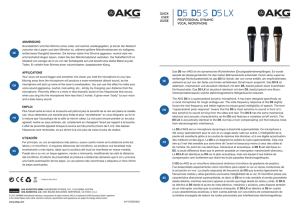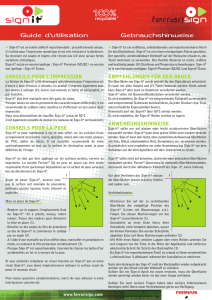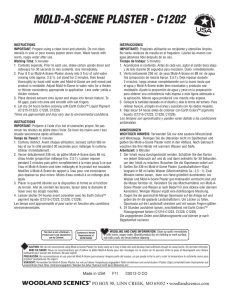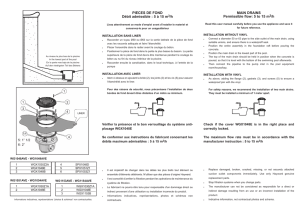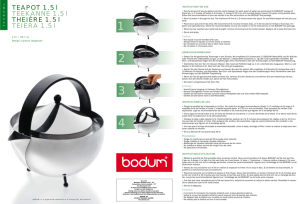Operating the C01
Anuncio
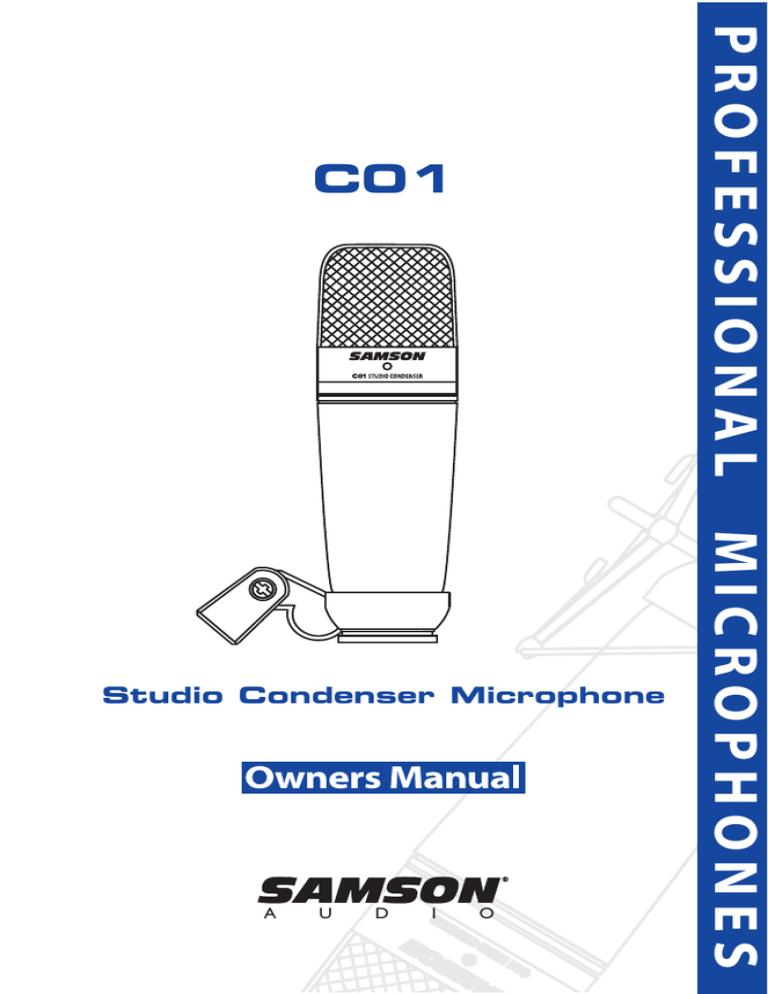
PROFESSIONAL C01 A U D I O MICROPHONES Studio Condenser Microphone Table Of Contents ENGLISH Introduction C01 Features Operating the C01 Powering the C01 Polar Pattern Microphone Placement Setting up the Signal Level P-Popping Stand Mounting the C01 Using the Optional SP01 Shock-mount 1 2 3 3 3 3 4 4 4 5 FRANÇAIS Introduction Présentation des fonctions du C01 Utilisation du C01 Mise sous tension du C01 Directivité Placement du micro Réglage du niveau du signal Bruits de Pop Installation sur pied Suspension anti-choc SP01 “Spider” optionnelle 6 7 8 8 8 8 9 9 9 10 DEUTSCHE Einleitung C01 Features C01 bedienen C01 mit Spannung versorgen Richtcharakteristik Mikrofonplatzierung Signalpegel einstellen Pop-Geräusche Ständermontage Der optionale SP01 “Spider”Anti-Schock 11 12 13 13 13 13 14 14 14 15 ESPAÑOL Introducción Funciones y características del C01 Utilizar el C01 Alimentación del C01 Patrón polar Ubicación del micrófono Ajustar el nivel de la señal Chasquido de P Montaje en pie Utilizar el aislante de golpes SP01 “Spider” opcional 16 17 18 18 18 18 19 19 19 20 Specifications 21 A K-TEAM P R O D UCTION Introduction In these pages, you’ll find a detailed description of the features of the C01 Studio Condenser Microphone, as well as step-by-step instructions for its setup and use, and full specifications. You’ll also find a warranty card enclosed— please don’t forget to fill it out and mail it in so that you can receive online technical support and so we can send you updated information about these and other Samson products in the future. With proper care and adequate air circulation, your C01 will operate trouble free for many years. We recommend you record your serial number in the space provided below for future reference. Serial number: Date of purchase: Should your unit ever require servicing, a Return Authorization number (RA) must be obtained before shipping your unit to Samson. Without this number, the unit will not be accepted. Please call Samson at 1-800-3SAMSON (1-800-3726766) for a Return Authorization number prior to shipping your unit. Please retain the original packing materials and if possible, return the unit in the original carton and packing materials. 1 ENGLISH Congratulations on your purchase of the Samson C01 studio condenser. The C01 features a large, 19mm ultra thin diaphragm capsule which faithfully reproduces a variety of sound sources including vocals, acoustic instruments and overhead cymbals to name a few. The extended frequency and fast transient response insures an accurate reproduction with linier characteristics from bottom to top. ENGLISH C01 Features C01 Features • Large Diaphragm Studio Condenser • 19mm Capsule with 3-micron diaphragm • Smooth and transparent sound reproduction • Hyper Cardioid Pick-Up Pattern • 36-52 Volt Phantom Power Operation with Blue LED • Internal Shock-mount • Extended frequency response • Solid Die Cast Construction • Swivel Stand Mount and Carry Case included 2 Operating the C01 Powering the C01 Polar Pattern The most important characteristic of any microphone is its directionality or “pickup pattern”. There are three basic categories of pick up patterns; omni, bi and uni-directional. Omni mics pick up sound from all directions, bi-directional (figure 8) mics pick up the sound directly in front and back of the microphone while rejecting the sound on the left and right sides, and uni-directional (cardioid) mics pick up the sound in front of the microphone. While omni and bi-directional microphones are very useful for a variety of applications, the majority of micing situations in recording and live sound require unidirectional or cardioid microphones. The uni-directional nature allows for better separation of instruments in the studio and more control over feedback in live sound reinforcement. The C01 condenser’s pick-up pattern is hyper-cardioid, which offers even more side-to-side rejection. When positioned correctly the hyper-cardioid pick-up pattern allows you to pick up more of the sound you want and less of the sound you don’t want. Microphone Placement In order to maximize the sound quality, you must pay careful attention to the placement of your C01 and how it is positioned for the instrument or vocalist that you are micing. All microphones, especially uni-directional or cardioid microphone exhibit a phenomenon known as proximity effect. Very simply put, proximity effect is a resulting change in the frequency response of a microphone based on the position of the mic capsule relative to the sound source. Specifically, when you point a cardioid mic directly at the sound source (on axis) you will get the best frequency response, however when you start pointing the microphone slightly away (off axis) you will notice the low frequency response dropping off and the microphone will start to sound thinner. For most vocals application you’ll want to position the microphone directly in front of the talent. The same may be true for micing instruments, however, you 3 ENGLISH The C01 is a condenser microphone and therefore needs to be operated by connecting a phantom power supply. Phantom power is standard on most quality mixers, outboard mic-pres and hard disk recorders. If necessary an external phantom supply can also be used. The C01 receives the phantom power directly from a mic cable when connected to a mixer or other microphone input that includes a phantom supply. The power is actually sent OUT of the microphone INPUT, riding silently along with the audio signal. (Fairly mysterious, eh?) Most mixers have a switch to engage the phantom power so be sure to check that the phantom power is on. The C01 features a blue LED, which will illuminate when phantom power is present. ENGLISH Operating the C01 can make some pretty amazing equalization adjustments by slightly changing the angle of the capsule to the sound source. This can be a very useful technique in capturing the optimum sound of drum set, acoustic guitar, piano or other instruments in a live room or sound stage. Experimentation and experience are the best teachers in getting good sounds, so plug in! Setting Up the Signal Level When connecting the C01 to a mixer or recorder input, be sure that the input is of microphone level. Also, be sure that the phantom power is engaged as explained the previous section “Powering the C01”. Most mixers and recorders of reasonable quality will offer a microphone input with mic trim (usual called Trim or Gain) control. The purpose of the mic trim control is to optimize the amount of good signal to any noise associated with the mixers electronics. A good mic pre with trim also will have a PEAK or CLIP LED. To set a good level on the mic, set the C01 up in front of the desired sound source and slowly raise the mic trim control until you see the PEAK LED light up. Then, turn the mix trim control down until the LED does not light any more. On most mixers the ideal setting is that the trim control is turned up as much as possible without lighting the PEAK LED. P-Popping P-Popping is that annoying pop that you can get when the microphone diaphragm gets a blast of air from a vocalist pronouncing words with the letter “P” included. There are a few ways to deal with the problem including using an external pop filter. Some famous engineers have relied on an old nylon stocking over a bent clothes hanger, which actually works very well. You can also try placing the microphone slightly off axis (on a slight angle) from the vocalist. This can often solve the problem without using an external pop filter. Stand Mounting the C01 The C01 can be mounted to a standard microphone stand using the included swivel mount adapter. If you are using a US 5/8” mic stand, you will need to remove, by unscrewing, the Euro stand adapter. Simply screw on the swivel adapter on your mic stand or boom arm. Now, loosen the thumbscrew and adjust the microphone to the desired angle. Once set, tighten the thumbscrew to secure the microphone in place. 4 Using the Optional SP01 Shock-Mount Using the Optional SP01 “Spider” Shock-Mount • First, screw the SP01 shock mount onto your mic stand or boom arm. If you’re using a US 5/8” mic stand or boom, remove the Euro adapter. • Remove the C01 swivel mount by rotating the threaded collar counterclockwise as shown in figure 1. • Install the C01 into the SP01 by fitting the microphone into the center of the web, positioning the C01 onto the bottom mounting plate. • • Secure the SP01 by reinstalling the threaded collar, rotating clockwise until tight. (Figure 2) Now, loosen the thumb screw to adjust the angle of the microphone and position the C01 to the desired location. Once set, tighten the thumbscrew to secure the microphone in place. 1 ENGLISH For additional isolation the C01 can be fitted on the optional SP01 “Spider” shock mount. Follow the steps below the to install the SP01. THREADED COLLAR 2 SP01 SHOCK MOUNT Note: Be careful not to cross thread or over tighten the threaded collar or thumb screw. THUMB SCREW THREADED COLLAR 5 Introduction FRANÇAIS Nous vous remercions de la confiance que vous nous témoignez en choisissant le micro à condensateur de studio C01 Samson. Le C01 est équipé d’une capsule à grand diamètre (19 mm) ultra-fine capable de reproduire fidèlement une grande variété de sources sonores, dont les voix, les instruments acoustiques voire les cymbales (en Overhead au-dessus de la batterie), pour ne citer que ces applications. Ce micro se caractérise en outre par une réponse en fréquence étendue et une réponse aux transitoires parfaitement maîtrisée, assurant toutes deux une reproduction fidèle des fréquences les plus basses aux plus aiguës. Dans ce manuel, vous trouverez une description détaillée des caractéristiques de ce micro à condensateur de studio C01, des instructions pas à pas pour son installation et son utilisation, ainsi que toutes les précisions sur ses caractéristiques techniques. Une carte de garantie est également fournie avec l’appareil. N’oubliez pas de la remplir et de nous l’envoyer afin de bénéficier de l’assistance technique en ligne et d’être informé des dernières informations concernant ce produit et toute la gamme des produits Samson. Une manipulation soigneuse et une bonne ventilation de l’appareil garantiront une fiabilité totale du C01 pendant de nombreuses années. Nous vous invitons à noter le numéro de série ci-dessous, afin de pouvoir vous y référer ultérieurement. Numéro de série : Date d’achat : Si votre appareil nécessite une réparation, vous devez tout d’abord obtenir un numéro d’autorisation avant de renvoyer l’appareil à Samson. À défaut de ce numéro, l’appareil ne sera pas accepté. Veuillez appeler le service après vente Samson au numéro suivant : 1-800-3SAMSON (1-800-372-6766) pour obtenir votre numéro d’autorisation et pouvoir renvoyer l’appareil. Conservez les éléments d’emballage d’origine ; utilisez-les si possible pour l’expédition et pour tout transport de l’appareil. 6 Présentation du C01 FRANÇAIS Principales caractéristiques du C01 : • Micro à condensateur de studio à large diaphragme • Capsule 19 mm avec diaphragme 3 microns • Reproduction fidèle et transparente • Polarité hyper-cardioïde • Alimentation fantôme 36-52 Volts (avec témoin led bleu) • Suspension interne anti-choc • Réponse en fréquence étendue • Fabrication en alliage robuste • Pince de fixation sur pied et coffret de transport fournis 7 Utilisation du C01 Mise sous tension du C01 FRANÇAIS Le C01 est un micro à condensateur, ce qui implique qu’il doit être alimenté par fantôme. La plupart des consoles de mixage, des préamplificateurs externes et des enregistreurs D-to-D disposent d’une alimentation de ce type. Une alimentation fantôme externe peut également être utilisée si nécessaire. Le C01 reçoit son alimentation directement sur le câble micro le reliant à la console ou à une autre entrée micro offrant ce type d’alimentation. L’alimentation est alors transmise avec le signal par le câble d’entrée micro de façon inaudible. La majorité des consoles de mixage disposent d’un commutateur permettant d’activer l’alimentation fantôme ; assurez-vous que celui-ci est bien enclenché. Le C01 intègre un témoin led bleu, qui s’allume lorsque le micro est sous tension. Directivité La caractéristique essentielle d’un micro est sa directivité. On distingue ainsi trois catégories : les micros omni-directionnels, bi-directionnels et uni-directionnels. Les micros omni-directionnels captent les sons en provenance de toutes les directions. Les micros bi-directionnels captent les sons provenant de l’avant et de l’arrière du micro et atténuent les sons latéraux (gauche, droite). Les micros uni-directionnels (cardioïdes) ne captent que les sons reçus de face. Les micros omni-directionnels et bi-directionnels s’avèrent très pratiques pour bon nombre d’applications. Les situations de prises de son les plus courantes (scène et enregistrement) nécessitent néanmoins l’utilisation d’un micro unidirectionnel (ou cardioïde). En effet, le ciblage du micro uni-directionnel offre une meilleure séparation des instruments en studio et un meilleur contrôle du Larsen sur scène. Le micro à condensateur C01 est de type hyper-cardioïde, afin d’offrir une réjection maximale des sons latéraux. Lorsqu’il est bien positionné, le micro hyper-cardioïde vous permet de faire ressortir ce que vous souhaitez entendre et d’atténuer encore plus efficacement ce que vous ne souhaitez pas entendre. Placement du micro Le positionnement du C01 par rapport à l’instrument ou au chanteur que vous enregistrez influence directement la qualité sonore finale. Tous les micros, et en particulier les micros uni-directionnels ou cardioïdes, sont très sensibles à un phénomène connu sous le nom “d’effet de proximité”. En termes simples, l’effet de proximité se caractérise par une variation de la réponse en fréquence du micro en fonction de la position de la capsule par rapport à la source sonore. Dans les faits, lorsque vous pointez un micro cardioïde en direction de la source sonore (dans l’axe), la réponse en fréquence s’améliore ; à l’inverse, lorsque vous désaxez le micro par rapport à la source, les graves sont plus particulièrement atténués et le son devient plus aigu. Pour la plupart des applications de chant, on cherchera à placer le micro juste devant l’artiste. La même règle peut s’appliquer pour la reprise d’instruments, 8 Utilisation du C01 cependant, de surprenantes nuances d’égalisation peuvent être obtenues en désaxant très légèrement la capsule par rapport à la source sonore. N’hésitez pas à faire appel à cette technique pour une prise optimale des sons de batterie, de guitare acoustique, de piano ou d’autres instruments, sur scène ou en studio. Rien ne saurait remplacer l’expérience dans le domaine de la prise de son, alors passez à la pratique ! Réglage du niveau du signal Bruits de pop Les “pops” sont des bruits désagréables produits par le micro lorsque le diaphragme reçoit le souffle d’un chanteur prononçant un “P”. Il existe différentes solutions permettant de palier ce problème, dont le recours à un filtre anti-pop externe. Certains ingénieurs du son parmi les plus prestigieux emploient pour cela un bon vieux bas nylon enfilé sur un porte-manteau tordu et obtiennent d’excellents résultats. Vous pouvez également désaxer légèrement le micro par rapport au chanteur ; cette technique, efficace dans bien des cas, offre l’avantage de rendre inutile le recours à un filtre anti-pop externe. Installation du C01 sur un pied Le C01 peut être installé sur un pied standard au moyen de l’adaptateur fourni. Si vous utilisez un pied à la norme américaine 5/8”, dévissez l’adaptateur pour la norme européenne. Vissez simplement la base filetée du micro sur votre pied ou votre perche. Dévissez la vis “rapide” de la rotule pour donner au micro l’axe souhaité. Une fois l’angle correct obtenu, serrez la vis pour maintenir le micro en place. 9 FRANÇAIS Lorsque vous connectez le C01 à l’entrée d’une console ou d’un enregistreur, assurez-vous que cette entrée est bien à niveau micro. Veillez également à ce que l’alimentation fantôme soit activée (voir le chapitre “Mise sous tension du C01”). La plupart des consoles et des enregistreurs de qualité sont équipés d’entrée micro avec réglage du gain (généralement appelé Trim ou Gain). Ce réglage de gain vous permet d’optimiser le niveau du signal micro par rapport au bruit de fond induit par l’électronique de la console. Un bon préamplificateur micro est en outre équipé de témoins d’écrêtage (PEAK ou CLIP). Pour obtenir un niveau micro idéal, placez le C01 en face de la source à enregistrer et augmentez progressivement le gain jusqu’à ce que le témoin PEAK s’allume. Baissez ensuite très légèrement le gain de telle sorte que le témoin reste éteint. Sur la plupart des consoles, le résultat optimal est obtenu en réglant le gain le plus haut possible sans que le témoin le témoin PEAK ne s’allume. Suspension anti-choc SP01 optionnelle FRANÇAIS Afin de garantir une isolation optimale du micro, le C01 peut être installé sur la suspension anti-choc SP01 “Spider” optionnelle. La procédure suivante vous indique comment installer le micro sur sa suspension SP01 : • Tout d’abord, vissez la suspension SP01 sur le pied ou sur la perche micro. Si vous utilisez un pied à la norme américaine 5/8”, retirez l'adaptateur à la norme européenne. • Retirez la pince de fixation sur pied du C01 en tournant la bague filetée dans dans le sens inverse des aiguilles d’une montre (voir fig. 1). • Installez le C01 sur la suspension SP01 en plaçant le micro au centre de la toile et en veillant à le positionner correctement sur la base. • Assurez la fixation à la suspension SP01 en remontant la bague filetée. Tournez-le dans le sens des aiguilles d’une montre (fig. 2) • Desserrez la vis rapide de la rotule pour régler l’angle du micro. Une fois l’angle approprié obtenu, serrez à nouveau la vis pour maintenir le micro en place. Note : Attention à ne pas abîmer le filetage ou à trop serrer la bague ou la vis rapide. Bague filetée SP01 Suspension anti-choc Vis rapide Bague filetée 10 Einleitung Herzlichen Glückwunsch zum Erwerb des Samson C01 StudioKondensatormikrofons. Das C01 zeichnet sich durch eine große, 19 mm ultradünne Membrankapsel aus, die vielfältige Klangquellen, wie Gesang, Akustikinstrumente und Overhead-Becken, originalgetreu reproduziert. Ein erweiterter Frequenzbereich und eine schnelle Transienten-Ansprache garantieren eine präzise, lineare Wiedergabe über das gesamte Klangspektrum. Auf diesen Seiten finden Sie eine detaillierte Beschreibung der Features des C01 Studio-Kondensatormikrofons sowie schrittweise Anleitungen für dessen Einrichtung und Einsatz – plus ausführlicher Technischer Daten. Sie werden auch eine Garantiekarte finden, die Sie ausfüllen und zurückschicken sollten, damit Sie in Zukunft technischen Online Support und aktuelle Informationen über dieses und andere Samson-Produkte erhalten. Bei korrekter Handhabung und angemessener Belüftung wird sich Ihr C01 über Jahre hinweg störungsfrei betreiben lassen. Die Seriennummer des Mikrofons sollten Sie hier eintragen, um bei Bedarf darauf zurückgreifen zu können. Seriennummer: ____________________________________ Kaufdatum: ____________________________________ 11 DEUTSCHE Sollte Ihr Gerät einmal gewartet werden müssen, besorgen Sie sich vor der Rücksendung an Samson bitte eine Return Authorization Number (RA) (Rückgabe-Berechtigungsnummer). Ohne diese Nummer wird das Gerät nicht angenommen. Bitte rufen Sie Samson unter der Nummer 1-800-3SAMSON (1800-372-6766) an, um eine RA-Nummer vor der Rücksendung zu erhalten. Heben Sie bitte das Originalverpackungsmaterial auf und schicken Sie das Gerät, falls möglich, im Originalkarton und mit dem Originalverpackungsmaterial zurück. DEUTSCHE C01 Features C01 Features • Studio-Kondensatormikrofon mit großer Membran • 19 mm Kapsel mit 3 Mikron Membran • ausgewogene und transparente Klangreproduktion • Hypernieren-Richtcharakteristik • 36 - 52 Volt Phantomspannungs-Betrieb mit blauer LED-Anzeige • interne Anti-Schockvorrichtung • erweiterter Frequenzgang • solide Spritzguss-Konstruktion • schwenkbarer Ständeraufsatz und Transportbox 12 C01 bedienen C01 mit Spannung versorgen Das C01 ist ein Kondensatormikrofon und muss bei Betrieb mit einer Phantomspannungsquelle verbunden werden. Bei den meisten hochwertigen Mischern, externen Mikro-Vorverstärkern und Harddisk-Recordern zählt Phantomspannung zur Standardausstattung. Nötigenfalls können Sie auch eine externe Phantomspannungsquelle benutzen.Wenn das C01 direkt an einen Mischer oder einen anderen, mit Phantomspannung ausgestatteten MikrofonEingang angeschlossen ist, empfängt es die Spannung direkt über das Mikrofonkabel. Die Spannung wird über den Mikrofon-EINGANG AUSGEGEBEN und läuft stillschweigend neben dem Audiosignal her (ziemlich mysteriös, oder?). Da sich die Phantomspannung bei den meisten Mischern über einen Schalter aktivieren lässt, sollten Sie sicherstellen, dass dieser auf EIN steht. Das C01 verfügt über eine blaue LED, die bei anliegender Phantomspannungleuchtet. Richtcharakteristik Die wichtigste Eigenschaft eines Mikrofons ist seine Richtcharakteristik oder sein “Pickup Pattern”. Davon gibt es drei Hauptkategorien: Omni, Bi- und Unidirektional. Omni-Mikros nehmen den Klang aus allen Richtungen auf, bidirektionale Mikros (8-er Bereich) nehmen den Klang direkt vor und hinter sich auf,wobei die von links oder rechts kommenden Klänge ignoriert werden. Unidirektionale (Nieren-) Mikros nehmen nur den von vorne kommenden Klang auf. Mikrofonplatzierung Um die Klangqualität des C01 zu maximieren, müssen Sie sorgfältig auf dessen Position und seine Ausrichtung auf das abzunehmende Instrument bzw. den Gesang achten. Alle Mikrofone, besonders unidirektionale oder NierenMikrofone, sind von einem Phänomen begleitet, das man “Proximity- oder Nahbesprechungseffekt” nennt. Dieser resultiert auf einer Änderung des Mikrofon-Frequenzgangs, der auf der Position der Mikrofonkapsel relativ zur Klangquelle beruht.Wenn Sie ein Nieren-Mikrofon direkt auf die Klangquelle (axial) ausrichten, erhalten Sie den besten Frequenzgang.Wenn Sie das Mikrofon allerdings geringfügig neben die Klangquelle (neben die Achse) richten, werden Sie ein Abfallen des Bassfrequenzgangs feststellen und das Mirofon 13 DEUTSCHE Obwohl omni- und bidirektionale Mikros für verschiedene Anwendungen sehr nützlich sind, erfordert die Mehrheit der Abnahmesituationen im Studio oder Live den unidirektionalen oder Nieren-Mikrofontyp. Der unidirektionale Charakter der Mikrofone ermöglicht eine bessere Trennung der Instrumente im Studio sowie mehr Kontrolle über Rückkopplungen bei der Live-Beschallung. Das C01 Kondensatormikrofon bietet eine Hypernieren-Charakteristik, bei der seitlich einfallender Schall noch stärker unterdrückt wird. Bei korrekter Positionierung können Sie mit der Hypernieren-Richtcharakteristik die erwünschten Klänge noch stärker von den unerwünschten Klängen trennen. C01 bedienen wird dünner klingen. Bei den meisten Gesangsanwendungen werden Sie das Mikro direkt vor dem Sänger positionieren. Das gleiche gilt wahrscheinlich für die Mikrofonabnahme von Instrumenten. Sie können allerdings ziemlich erstaunliche EQ-Einstellungen vornehmen, indem Sie den Winkel der Kapsel zur Klangquelle etwas verändern. Mit dieser Technik lässt sich oft der optimale Sound für Drumsets, Akustikgitarren, Pianos oder andere Instrumente in einem reflektierenden Raum oder auf einer Bühne einfangen. Experiment und Erfahrung sind die besten Lehrer – also anschließen und loslegen! DEUTSCHE Signalpegel einstellen Wenn Sie das C01 an einen Mischer- oder Recorder-Eingang anschließen, sollte dieser auf Mikrofonpegel ausgelegt sein. Achten Sie auch darauf, dass die Phantomspannung aktiviert ist (siehe vorheriger Abschnitt “C01 mit Spannung versorgen”). Die meisten Mischer und Recorder mittlerer Qualität und höher bieten Mikrofon-Eingänge mit Trim- oder Gain-Regler. Dieser Mic Trim-Regler soll den Anteil an Nutzsignal im Verhältnis zu dem von der Mischerelektronik verursachten Rauschen optimieren. Ein guter Mikro-Vorverstärker mit TrimRegler besitzt auch eine PEAK oder CLIP LED. Um einen guten Mikropegel einzustellen, bauen Sie das C01 vor der gewünschten Klangquelle auf und drehen Sie den Mic Trim-Regler langsam auf, bis die PEAK LED leuchtet. Drehen Sie dann den Mix Trim-Regler zurück, bis die LED nicht mehr leuchtet. Bei den meisten Mischern erhalten Sie die Idealeinstellung, indem Sie den TrimRegler so weit wie möglich aufdrehen, ohne dass die PEAK LED leuchtet. Pop-Geräusche Pop-Geräusche erhalten Sie, wenn ein Sänger Wörter mit einem “P” benutzt und der dadurch erzeugte Luftstoß direkt auf die Mikrofon-Membran trifft. Um das Problem zu lösen, können Sie u.a. ein externes Pop-Filter verwenden. Einige berühmte Tontechniker benutzen alte Nylonstrümpfe, die sie über rund gebogene Kleiderbügel gespannt haben. Und es funktioniert sehr gut. Sie können auch versuchen, das Mikrofon nicht direkt auf den Sänger (sondern in einem kleinen Winkel) auszurichten. Damit lässt sich das Problem oft lösen, ohne ein externes Pop-Filter zu verwenden. Ständermontage des C01 Mit dem beiliegenden schwenkbaren Adapter können Sie das C01 auf einen normalen Mikrofonständer montieren. Bei einem U.S. 5/8” Mikroständer müssen Sie den Adapter für Euro-Ständer abschrauben. Schrauben Sie dann einfach den schwenkbaren Adapter auf Ihren Mikro- oder Galgenständer auf. Lösen Sie dann die Rändelschraube und stellen Sie das Mikrofon auf den gewünschten Winkel ein. Drehen Sie danach die Rändelschraube wieder fest, um das Mikro zu fixieren. 14 Optionalen SP01 Anti-Schock verwenden Optionalen SP01 “Spider”Anti-Shock verwenden Zwecks zusätzlicher Isolation können Sie das C01 auf den optionalen SP01 “Spider” Anti-Schock montieren. Gehen Sie hierbei wie folgt vor: Schrauben Sie zunächst den SP01 Anti-Schock auf Ihren Mikro- oder Galgenständer. Falls Sie einen US 5/8” Mikro- oder Galgenständer verwenden, müssen Sie den EuroAdapter entfernen. • Entfernen Sie die C01 Schwenkvorrichtung, indem Sie den Gewindering wie in Abb. 1 nach links drehen. • Installieren Sie das C01 im SP01, indem Sie das Mikrofon in die Mitte des Netzes einsetzen und es auf dem Boden der Montageplatte positionie ren. • Sichern Sie den SP01, indem Sie den Gewindering durch eine Rechtsdrehung bis zum Anschlag wieder montieren (Abb. 2). • Lockern Sie jetzt die Rändelschraube, um den Winkel des Mikrofons einzustellen, und richten Sie das C01 auf die gewünschte Position aus. Drehen Sie anschießend die Rändelschraube wieder fest, um das Mikrofon zu fixie ren. Anmerkung: Achten Sie darauf, dass Sie den Gewindering und die Rändelschraube nicht in die falsche Richtung oder zu fest dre hen. GEWINDERING SP01 ANTI-SCHOCK RÄNDELSCHRAUBE GEWINDERING 15 DEUTSCHE • Introducción Le felicitamos por la compra del micrófono condensador de estudio C01 de Samson. El C01 incorpora una gran cápsula del diafragma ultrafina de 19 mm que reproduce con gran fidelidad muchas fuentes de sonido, incluyendo vocales, instrumentos acústicos y platos de batería, por citar sólo algunos. La amplia respuesta de frecuencia y la rápida respuesta dinámica garantizan una reproducción muy precisa con características lineales de principio a fin. En estas páginas encontrará una descripción detallada de las funciones y las características del micrófono condensador de estudio C01, así como instrucciones paso a paso para su instalación y uso, y también unas especificaciones completas. También encontrará una tarjeta de garantía adjunta—no olvide rellenarla y enviárnosla por correo para así poder recibir asistencia técnica online y para que podamos enviarle información actualizada acerca de éstos y otros productos Samson en el futuro. Con el cuidado apropiado y una adecuada circulación del aire, el C01 funcionará sin problemas durante muchos años. Le aconsejamos que anote su número de referencia en el espacio que se ofrece a continuación para futuras referencias. Número de serie: ESPAÑOL Fecha de compra: Si alguna vez debe enviar la unidad al servicio de reparaciones, deberá obtener un número de Autorización de retorno (RA) antes de enviar la unidad a Samson. Sin este número no se aceptará la unidad. Llame a Samson al 1-8003SAMSON (1-800-372-6766), donde le darán un número de Autorización de retorno antes de enviar la unidad. Guarde los materiales de embalaje originales y, si es posible, envíe la unidad dentro de caja y materiales de embalaje originales. 16 Funciones y características del C01 Funciones y características del C01 Micrófono condensador de estudio con diafragma de gran tamaño • Cápsula de 19 mm con diafragma de 3 micras • Reproducción del sonido suave y transparente • Patrón de captación del sonido hipercardiode • Funcionamiento con potencia fantasma a 36-52 voltios con LED azul • Aislante de golpes interno • Respuesta de frecuencia ampliada • Construcción por fundición a presión sólida • Pivote giratorio para pie y bolsa de transporte incluidos 17 ESPAÑOL • Utilizar el C01 Alimentación del C01 El C01 es un micrófono condensador y, por lo tanto, debe utilzarse conectando una fuente de alimentación con potencia fantasma. La potencia fantasma es una característica estándar en la mayoría de mezcladores, etapas de potencia y grabadoras de disco duro de calidad. Si es necesario, también puede utilizar una fuente de potencia fantasma externa. El C01 recibe la potencia fantasma directamente de un cable de micrófono cuando está conectado a un mezclador o a otra entrada de micrófono que incluya una fuente de potencia fantasma. En realidad, la potencia se envía DESDE la ENTRADA de micrófono, y discurre silenciosamente junto con la señal de audio. (¿Misterioso, no?) La mayoría de los mezcladores disponen de un conmutador para activar la potencia fantasma, con lo cual deberá comprobar que la potencia fantasma esté activada. El C01 dispone de un LED de color azul que se iluminará cuando la potencia fantasma esté presente. Patrón polar La característica más importante de cualquier micrófono es su direccionalidad o “patrón de captación”. Existen tres categorías básicas de patrones de captación; omnidireccional, bidireccional y unidireccional. Los micrófonos omnidireccionales captan el sonido en todas direcciones, los bidireccionales (figura 8) captan el sonido directamente delante y detrás del micrófono y rechazan el sonido de la derecha y la izquierda, y los unidireccionales (cardioides) captan el sonido delante del micrófono. Aunque los micrófonos omnidireccionales y bidireccionales son muy útiles para muchas aplicaciones, la mayoría de situaciones de “micrófonos” para la grabación y el sonido en vivo requieren micrófonos unidireccionales o cardioides. La naturaleza unidireccional permite una mejor separación de los instrumentos en el estudio y un mayor control sobre la realimentación en el reforzamiento del sonido en vivo. El patrón de captación del micrófono condensador C01 es hipercardioide, con lo cual ofrece un mayor rechazo del sonido lateral. Cuando se coloca correctamente, el patrón de captación hipercardioide permite captar una mayor parte del sonido deseado y una menor parte del sonido no deseado. ESPAÑOL Ubicación del micrófono Para maximizar la calidad del sonido hay que prestar mucha atención a la ubicación del C01 y a cómo está situado para el instrumento o vocalista que va a captar con el micrófono. Todos los micrófonos, especialmente los unidireccionales o cardioides, muestran un fenómeno conocido como “efecto de proximidad.” Para explicarlo muy sencillamente, el efecto de proximidad es el cambio resultante en la respuesta de frecuencia de un micrófono según la posición de la cápsula del micrófono con relación a la fuente de sonido. Específicamente, al apuntar un micrófono cardioide directamente hacia la fuente de sonido (en eje) obtendrá la mejor respuesta de frecuencia, pero si empieza a desviar ligeramente el micrófono (fuera de eje) observará que la respuesta de frecuencia baja cae y el micrófono empieza a sonar con una menor densidad. 18 Utilizar el C01 Para la mayoría de las aplicaciones vocales deseará colocar el micrófono delante del artista. Esto también es así para captar instrumentos, pero pueden realizarse algunos ajustes de ecualización realmente increíbles cambiando ligeramente el ángulo de la cápsula con relación a la fuente de sonido. Ésta puede ser una técnica muy útil para capturar el sonido óptimo de un grupo de instrumentos de percusión, una guitarra acústica, un piano u otros instrumentos en una sala viva o estudio. La experimentación y la experiencia son los mejores maestros para conseguir un buen sonido, o sea que, ¡conéctese! Ajustar el nivel de la señal Al conectar el C01 a la entrada de un mezclador o una grabadora, compruebe que la entrada sea de nivel de micrófono. Además, compruebe que la potencia fantasma esté activada tal como se explica en la sección anterior “Alimentación del C01”. La mayoría de los mezcladores y grabadoras de una calidad razonable ofrecen una entrada de micrófono con control de recorte para micrófono (normalmente llamada Trim o Gain). La finalidad del control de recorte es optimizar la cantidad de señal buena con relación a cualquier ruido asociado con los mezcladores electrónicos. Un buen preamplificador de micrófono con recorte también tendrá un LED PEAK o CLIP. Para ajustar un nivel adecuado en el micrófono, coloque el C01 delante de la fuente de sonido y suba lentamente el control de recorte del micrófono hasta que el LED PEAK se ilumine. A continuación, baje el control de recorte hasta que el LED deje de iluminarse. En la mayoría de los mezcladores, el ajuste ideal es que el control de recorte esté al nivel más alto posible sin que se ilumine el LED PEAK. Chasquido de P Instalar el C01 en un pie El C01 puede instalarse en un pie de micrófono estándar utilizando el adaptador para pivote giratorio incluido. Si utiliza un pie de micrófono de 5/8” de los EE.UU., deberá desmontar, retirando el tornillo, el adaptador para pie Euro. Simplemente atornille el adaptador para pivote giratorio en el soporte o pie de jirafa para micrófono. Ahora afloje el tornillo y ajuste el micrófono al ángulo deseado. Una vez ajustado, apriete el tornillo para fijar el micrófono en su posición. 19 ESPAÑOL El chasquido de P es este molesto chasquido que se obtiene cuando el diafragma del micrófono recibe un golpe de aire de un vocalista que pronuncia palabras que contiene la letra “P”. Existen algunas manera de solucionar este problema, incluyendo la utilización de un filtro externo. Algunos famosos ingenieros utilizan una media de nilón sobre un colgador doblado, lo cual funciona muy bien. También puede colocarse el micrófono ligeramente fuera de eje (ligeramente desviado) con relación al vocalista. Con ello normalmente puede solucionarse el problema sin utilizar un filtro externo. Utilizar el aislante de golpes SP01 opcional Utilizar el aislante de golpes “Spider” SP01 opcional Para un aislamiento adicional, el C01 puede instalarse en el aislante de golpes SP01 “Spider” opcional. Siga los pasos que se dan a continuación para instalar el SP01. • En primer lugar, atornille el aislante de golpes SP01 en el soporte para micrófono o pie de jirafa. Si utiliza un soporte o jirafa de 5/8” de los EE.UU., retire el adaptador Euro. • Retire el pivote giratorio del C01 girando el cuello roscado en sentido antihorario, tal como muestra la figura 1. • Instale el C01 en el SP01 introduciendo el micrófono en el centro de la telaraña, colocando el C01 sobre la placa de montaje inferior. • Fije el SP01 volviendo a instalar el cuello roscado, girándolo en sentido antihorario hasta que quede firmemente fijado. (Figure 2) • Ahora afloje el tornillo para ajustar el ángulo del micrófono y colocar el C01 en la posición deseada. Una vez ajustado, apriete el tornillo para fijar el micrófono en su posición. 1 CUELLO ROSCADO ESPAÑOL 2 AISLANTE DE GOLPES DEL SP01 Nota: Tenga cuidado de no dañar o apretar en exceso el cuello roscado o el tornillo. TORNILLO CUELLO ROSCADO 20 C01 Specifications C01 Specifications Frequency Response Polar pattern: Element type Diaphragm thickness Sensitivity SPL Impedence Power supply voltage: Weight Dimensions 40~18000 HZ Hyper- cardioid Back condenser type 3mm -33 dB/Pa 136 dB 200 Ohms phantom power 36V - 52V 2 lbs. (30.9 kg) Height: 24.5" (62.2 cm) Width: 24.4" (62.2 cm), Depth: 18.5" (47.0 cm) 1,15 kg, (2,5 lbs.) Shipping Weight Caractéristiques techniques Réponse en fréquence : Directivité : Type d’élément : Épaisseur du diaphragme : Sensibilité : Niveau de pression sonore (SPL) : Impédance Alimentation : Poids : Dimensions : Poids brut : 40~18 000 Hz Hyper-cardioïde Condensateur à charge arrière 3 microns -33 dB/Pa 136 dB 200 Ohms Fantôme 36 V - 52 V 0,90 Kg Hauteur : 180 mm, Largeur : 54 mm Profondeur : 54 mm 1,15 kg, (2,5 lbs.) Les caractéristiques de l’appareil sont susceptibles d’être modifiées sans avis préalable. C01 Technische Daten Frequenzgang Richtcharakteristik Elementtyp MembranEmpfindlichkeit Schalldruckpegel Impedanz Versorgungsspannung Gewicht Abmessungen 40 ~ 18000 Hz Hyperniere Kondensator Dicke 3 mm -33 dB/Pa 136 dB 200 Ohms Phantomspannung 36 V - 52 V 0,91 kg (2 lbs.) Höhe: 180 mm (7"), Breite: 54 mm (2,125"), Tiefe: 54 mm (2,125") 1,15 kg, (2,5 lbs.) Frachtgewicht Technische Daten können ohne Vorankündigung geändert werden. Especificaciones del C01 Respuesta de frecuencia Patrón polar: Tipo de elemento Grosor del diafragma Sensibilidad SPL Impedancia Tensión de la fuente de alimentación: Peso Dimensiones Peso total del envío 40~18000 HZ Hipercardioide Tipo condensador posterior 3 micras -33 dB/Pa 136 dB 200 Ohms potencia fantasma de 36V a 52V 2 lbs. (30,9 kg) Alto: 7" (180 mm), Ancho: 2,125" (54 mm), Largo: 2,125" (54 mm) 1,15 kg, (2,5 lbs.) Especificaciones sujetas a cambios sin previo aviso. 21 C01 POLAR PATTERN 0 5 10 15 20 25 45 90 45 90 dB 135 135 180 C01 FREQUENCY RESPONSE +20 +10 0 0 -10 180 -20 -30 20 50 100 200 500 1K 2K 5K Samson Technologies Corp. 575 Underhill Blvd. P.O. Box 9031 Syosset, NY 11791-9031 Phone: 1-800-3-SAMSON (1-800-372-6766) Fax: 516-364-3888 www.samsontech.com A U D I O 10K 20K
